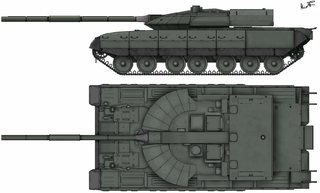
The T-72 is a family of Soviet/Russian main battle tanks that entered production in 1969. The T-72 was a development of the T-64, which was troubled by high costs and its reliance on immature developmental technology. About 25,000 T-72 tanks have been built, and refurbishment has enabled many to remain in service for decades. It was widely exported and saw service in 40 countries and in numerous conflicts. The T-90 introduced in 1992 is a relatively minor development of the T-72B, though production and development of the T-72 continues today.

The T-54 and T-55 tanks are a series of Soviet main battle tanks introduced in the years following the Second World War. The first T-54 prototype was completed at Nizhny Tagil by the end of 1945. From the late 1950s, the T-54 eventually became the main tank for armoured units of the Soviet Army, armies of the Warsaw Pact countries, and many others. T-54s and T-55s have been involved in many of the world's armed conflicts since their introduction in the last half of the 20th century.

The T-64 is a Soviet second-generation main battle tank introduced in the early 1960s. It was a more advanced counterpart to the T-62: the T-64 served in tank divisions, while the T-62 supported infantry in motorized rifle divisions. It introduced a number of advanced features including composite armor, a compact engine and transmission, and a smoothbore 125-mm gun equipped with an autoloader to allow the crew to be reduced to three so the tank could be smaller and lighter. In spite of being armed and armored like a heavy tank, the T-64 weighed only 38 tonnes.

The T-62 is a Soviet main battle tank that was first introduced in 1961. As a further development of the T-55 series, the T-62 retained many similar design elements of its predecessor including low profile and thick turret armour. In contrast with previous tanks, which were armed with rifled tank guns, the T-62 was the first production tank armed with a smoothbore tank gun that could fire APFSDS rounds at higher velocities. While the T-62 became the standard tank in the Soviet arsenal, it did not fully replace the T-55 in export markets due to its higher manufacturing costs and maintenance requirements compared to its predecessor. Although the T-62 was replaced in Russia and the successor states of the Soviet Union, it is still used in some countries and its design features became standardised in subsequent Soviet and Russian mass-produced tanks.

The T-80 is a main battle tank (MBT) that was designed in the former Soviet Union and is now manufactured in Russia. The T-80 is based on the T-64, while incorporating features from the later T-72. When it entered service in 1976, it was the second MBT in the world to be equipped with a gas turbine engine after the Swedish Strv 103 and the first to use it as a primary propulsion engine. The T-80U was last produced in a factory in Omsk, Russia, while the T-80UD and further-developed T-84 continue to be produced in Ukraine. The T-80 and its variants are in service in Belarus, Cyprus, Egypt, Kazakhstan, Pakistan, Russia, South Korea, and Ukraine. The chief designer of the T-80 was the Soviet engineer Nikolay Popov.

The T-90 is a third-generation Russian main battle tank. It uses a 125 mm 2A46 smoothbore main gun, the 1A45T fire-control system, an upgraded engine, and gunner's thermal sight. Standard protective measures include a blend of steel and composite armour, smoke grenade dischargers, Kontakt-5 explosive-reactive armour and the Shtora infrared ATGM jamming system

The T-84 is a Ukrainian main battle tank (MBT), a development of the Soviet T-80 main battle tank introduced in 1976. The T-84 was first built in 1994 and entered service in the Ukrainian Armed Forces in 1999. The T-84 is based on the diesel-engined T-80 version, the T-80UD. Its high-performance opposed-piston engine makes it one of the fastest MBTs in the world, with a power-to-weight ratio of about 26 horsepower per tonne.

Kharkiv Morozov Machine Building Design Bureau, often simply called Morozov Design Bureau or abbreviated KMDB, is a state-owned company in Kharkiv, Ukraine, which designs armoured vehicles, including the T-80UD and T-84 main battle tanks, as well as military prime movers. It was responsible for many important Soviet AFVs, including the BT tank series and the T-34, T-54, and T-64 tanks. It is closely associated with the Malyshev Factory.
T-95, or Object 195, is the common informal designation of a Russian fourth-generation main battle tank that was under development at Uralvagonzavod from 1988 until its cancelation in 2010. Little about the tank is publicly known. The work from the Object 195 was used in the Object 148, later type classified as the T-14 Armata, which began production in 2016.

The Black Eagle tank was a presumed prototype main battle tank produced in the Russian Federation. Based upon the T-80U, it was thought to have been developed by the KBTM design bureau in Omsk in the late 1990s. A production version of this tank has never been publicly demonstrated. The Black Eagle has been cancelled, with all production and development halted.
UralVagonZavod is a Russian machine building company located in Nizhny Tagil, Russia.

The T-44 is a medium tank first developed and produced near the end of World War II by the Soviet Union. It was the successor to the T-34, offering an improved ride and cross-country performance, along with much greater armor. Designed to be equipped with an 85 mm main gun, by the time it was fully tested the T-34 had also moved to this weapon. Both tanks offered similar performance, so introducing the T-44 was not considered as important as increasing T-34 production. Fewer than 2,000 T-44s were built, compared to about 58,000 T-34s. Although the T-44 was available by the end of the war, it was not used in any battle. It was 1 ton lighter than the T-34-85 and slightly faster. The T-44 was heavily influential on the design of the T-54/55 main battle tank, most notably the removal of side sloping, thick frontal armor, and a low profile. Also notable was the T-44-100, a 100 mm D-10T-armed prototype, which would be the same 100 mm gun mounted on the T-54/55, bar some minor changes.

The Malyshev Factory, formerly the Kharkov Locomotive Factory, is a state-owned manufacturer of heavy equipment in Kharkiv, Ukraine. It was named after the Soviet politician Vyacheslav Malyshev. The factory is part of the State Concern UkrOboronProm.

The TR-85 is a third-generation main battle tank designed for the armed forces of Romania. Based on the TR-77-580, the TR-85 tank was developed from 1978 to 1985 and produced from 1986 until 1990. A modernization program was initiated in March 1994 in order to upgrade the TR-85 tanks to NATO standards. The result was the TR-85M1 Bizonul ("Bison") main battle tank, currently the most modern tank in service with the Romanian Land Forces. Although a further development of the T-55, the TR-85M1 uses a T-block powerpack based on a V8 German 830 hp (620 kW) diesel engine, an improved turret, a locally-designed "Ciclop" fire control system, new 100 mm BM-412 Sg APFSDS-T projectiles and a completely redesigned suspension with 6 road wheels on each side, protected by metal side skirts. Combat weight is 50 tons.

The BMPT "Terminator" is an armored fighting vehicle (AFV), designed and manufactured by the Russian company Uralvagonzavod. This vehicle was designed for supporting tanks and other AFVs in urban areas. The BMPT is unofficially named the "Terminator" by the manufacturers. It is heavily armed and armored to survive in urban combat. The AFV is armed with four 9M120 Ataka missile launchers, two 30 mm 2A42 autocannons, two AG-17D grenade launchers, and one coaxial 7.62 mm PKTM machine gun.
Object 187 was a Soviet experimental main battle tank developed between the late 1980s and middle 1990s. It remains a relatively unpublicized development because of high levels of secrecy surrounding the project.

Russian Expo Arms is the international exhibition of arms, military equipment and ammunition that is regularly held in Nizhny Tagil, Russia since 1999.

The ATOM is a heavy 8×8 infantry fighting vehicle (IFV) jointly developed by the Russian company Petrel and the French company Renault Trucks. The vehicle is established on the basis of the French Véhicule blindé de combat d'infanterie (VBCI) IFV which is produced by Renault. The prototype of the ATOM was first unveiled during the 2013 Russian Arms Expo at Nizhny Tagil, equipped with a unique fighting module.
Object 490A "Rebel" was a Soviet experimental main battle tank developed between 1981 and 1982. Only two prototypes were ever produced, neither of which were capable of firing due to time constraints. Neither of the vehicles were completed before their production was ceased.

The Object 770 was a prototype heavy tank designed by Pavel Isakov.
















